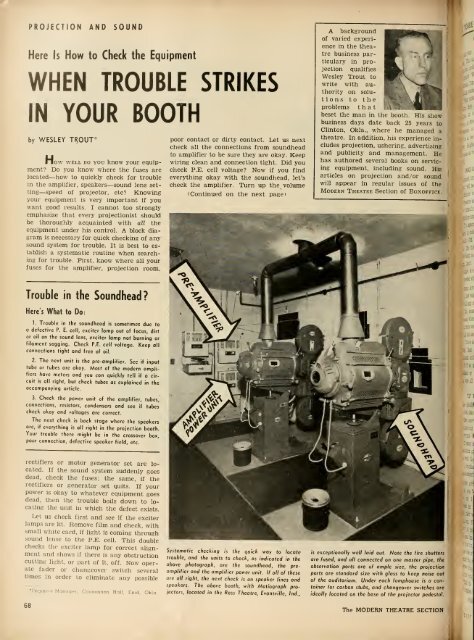You also want an ePaper? Increase the reach of your titles
YUMPU automatically turns print PDFs into web optimized ePapers that Google loves.
PROJECTION AND SOUND<br />
Here Is<br />
How to Check the Equipment<br />
WHEN TROUBLE STRIKES<br />
IN<br />
YOUR BOOTH<br />
riow WELL DO YOU know your equipment?<br />
Do you know where the fuses are<br />
located—how to quickly check for trouble<br />
in the amplifier, speakers—sound lens setting—speed<br />
of projector, etc? Knowing<br />
your equipment is very important if you<br />
want good results. I cannot too strongly<br />
emphasize that every projectionist should<br />
be thoroughly acquainted with all the<br />
equipment under his control. A block diagram<br />
is necessary for quick checking of any<br />
sound system for trouble. It is best to establish<br />
a systematic routine when searching<br />
for trouble. First, know where all your<br />
fuses for the amplifier, projection room.<br />
by WESLEY TROUT^<br />
poor contact or dirty contact. Let us next<br />
check all the connections from soundhead<br />
to amplifier to be sure they are okay. Keep<br />
wiring clean and connection tight. Did you<br />
(Continued on the next pagei<br />
Trouble in the Soundhead?<br />
Here's What to Do:<br />
1. Trouble in the soundhead is sometimes due to<br />
a defective P. E. cell, exciter lamp out of focus, dirt<br />
or oil on the sound lens, exciter lamp not burning or<br />
filament sagging. Check P.E. cell voltage. Keep all<br />
connections tight and free of oil.<br />
2. The next unit is the pre-amplifier. See if input<br />
tube or tubes are okay. Most of the modern amplifiers<br />
have meters and you can quickly tell if a circuit<br />
is all right, but check tubes as explained in the<br />
accompanying article.<br />
3. Check the power unit of the amplifier, tubes,<br />
connections, resistors, condensers and see it tubes<br />
check okay and voltages ore correct.<br />
The next check is bock stage where the speakers<br />
are, if everything is oil right in the projection booth.<br />
Your trouble there might be in the crossover box,<br />
poor connection, defective speaker field, etc.<br />
rectifiers or motor generator set are lo-<br />
Let us check first and see if the exciter<br />
lamps are lit. Remove film and check, with<br />
small white card, if light is coming through<br />
Systematic checking is the quick way (o locate<br />
trouble, and the units to check, as indicated in the<br />
above photograph, arc the soundhead, the preamplifier<br />
and the amplifier power unit. If all of these<br />
arc all right, the next check is on speaker lines and<br />
speakers. The above booth, with Motiograph pro-<br />
"Engineer-Manager, Convonlion Hall, Enid, Okla.<br />
cated. If the sound system suddenly goes<br />
dead, check the fuses; the same, if the<br />
rectifiers or generator set quits. If your<br />
power is okay to whatever equipment goes<br />
dead, then the trouble boils down to locating<br />
the unit in which the defect exists.<br />
sound lense to the P.E. cell. This double<br />
checks the exciter lamp for correct alignment<br />
and .shows if there is any obstruction<br />
cutting light, or part of it, off. Now operate<br />
fader or changeover switch several<br />
times in order to eliminate any possible<br />
check P.E. cell voltage? Now if you find<br />
everything okay with the soundhead, let's<br />
check the amplifier. Turn up the volume<br />
lecton, located in the Ross Theatre, Evansville, Ind.,<br />
A<br />
background<br />
of varied experience<br />
in the theatre<br />
business particulary<br />
in projection<br />
qualifies<br />
Wesley Trout to<br />
write with authority<br />
on solutions<br />
to the<br />
problems that<br />
beset the man in the booth.<br />
His show<br />
business days date back 25 years to<br />
Clinton, Okla., where he managed a<br />
theatre. In addition, his experience includes<br />
projection, ushering, advertising<br />
and publicity and management. He<br />
has authored several books on servicing<br />
equipment, including sound. His<br />
articles on projection and/or sound<br />
will appear in regular issues of the<br />
Modern Theatre Section of <strong>Boxoffice</strong>.<br />
is exceptionally well laid out. Note the fire shutters<br />
are fused, and all connected on one master pipe, the<br />
observation ports are of ample size, the projection<br />
ports are standard size with glass to keep noise out<br />
of the auditorium. Under each lamphouse is a container<br />
for carbon stubs, and changeover switches are<br />
ideally located on the base of the projector pedestal.<br />
r<br />
.-dllie<br />
^*tt<br />
'i%<br />
68<br />
The MODERN THEATRE SECTION<br />
r'TF

















